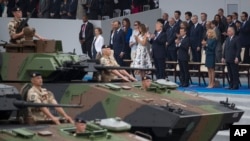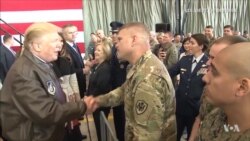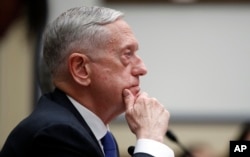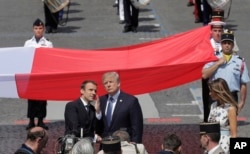U.S. President Donald Trump wants a military parade in Washington to top the one he watched last Bastille Day in France, ordering Pentagon leaders to make plans for a show of military might in the American capital.
Defense Secretary Jim Mattis said Wednesday that military officials were putting together some options for a parade and would present them to Trump for a decision.
"We're all aware of the president's affection and respect for the military," Mattis told reporters at the White House.
WATCH: Trump parade
Possible dates include three existing U.S. national holidays — Memorial Day on May 28 that traditionally honors U.S. war dead, Independence Day on July 4 when there already is a mammoth fireworks show on the National Mall in Washington, and Veterans Day on November 11, which this year coincides with the 100th anniversary of the victorious end of World War I.
The military reportedly favors the November date to divorce the aura of the parade and its symbolism of U.S. military strength as much as possible from the contentious U.S. political scene, since the parade would then fall days after congressional elections set for November 6.
White House press secretary Sarah Huckabee Sanders said, "President Trump is incredibly supportive of America's great service members who risk their lives every day to keep our country safe. He has asked the Department of Defense to explore a celebration at which all Americans can show their appreciation." But she described the parade plans as "really in the brainstorming stage."
Trump has remarked that he'd like a U.S. military parade to top the one he watched in Paris last July 14, when he and first lady Melania Trump were the guests of French President Emmanuel Macron and his wife, Brigitte.
The Washington Post said that Trump ordered planning for the parade at a January 18 meeting with the Pentagon's top officials, including Mattis and Joint Chiefs Chairman General Joseph Dunford.
The newspaper quoted one military official as saying, "The marching orders were: 'I want a parade like the one in France.' This is being worked at the highest levels of the military."
When Trump saw Macron in September at the U.N. General Assembly in New York, he again brought up the Bastille Day parade.
"It was one of the greatest parades I've ever seen," Trump told reporters. "It was two hours on the button, and it was military might, and I think a tremendous thing for France and for the spirit of France."
Trump told Macron, who was seated next to him, "We're going to have to try to top it."
Military parades of the grandeur Trump is apparently envisioning are not common in the U.S., even as small military units often march in Fourth of July celebrations in towns and cities across the country or at the quadrennial presidential inaugural parades in Washington, such as last year's when Trump became the 45th U.S. president.
Overt displays of military weaponry are seldom seen in the U.S., unlike the Soviet Union's decades-old Red Square celebrations or those in Pyongyang staged in recent years by North Korean leader Kim Jong Un. But U.S. President George H.W. Bush had military hardware in a 1991 parade celebrating victory in the Persian Gulf War and Presidents Harry S. Truman and John F. Kennedy displayed military might at their inaugural parades in 1949 and 1961, respectively, at the height of the Cold War.




























